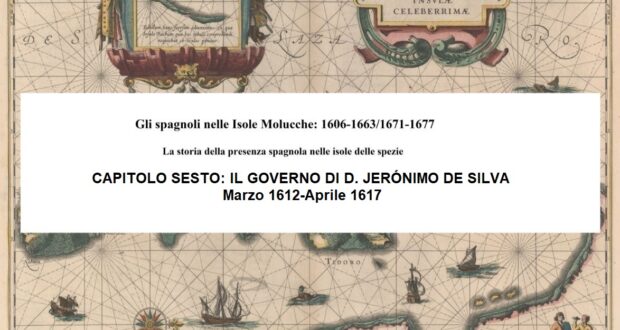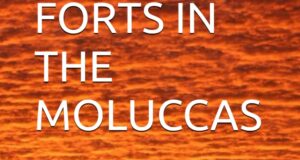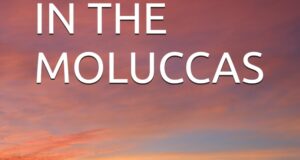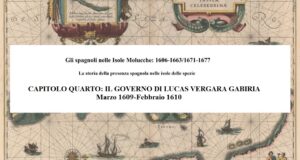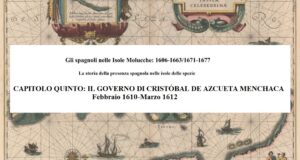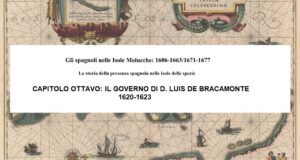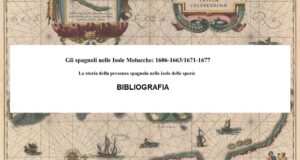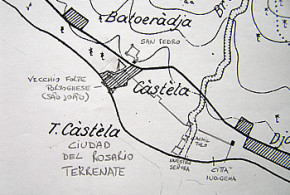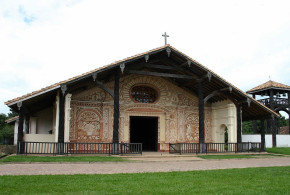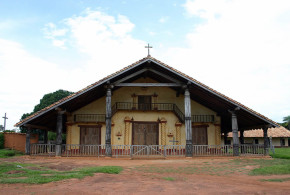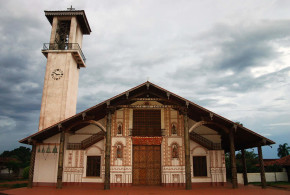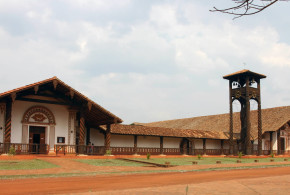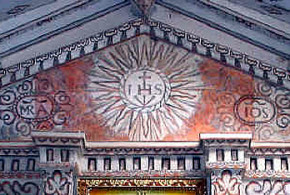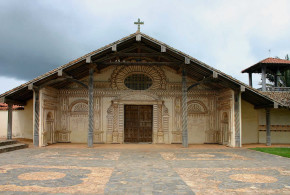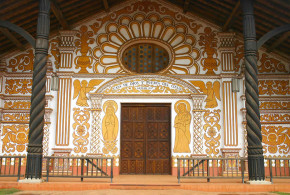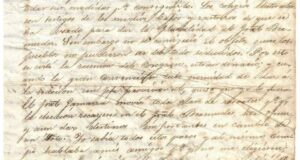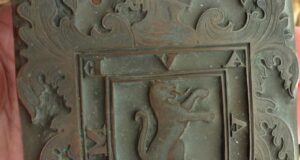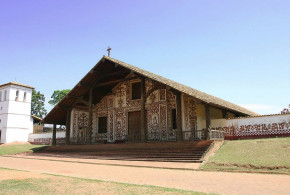This post is also available in:
![]() Italiano
Italiano
The Spaniards in the Moluccas: 1606-1663/1671-1677. The history of the Spanish presence in the spice islands
Written by Marco Ramerini. 2005-2020/23
CHAPTER SIX: THE GOVERNMENT OF D. JERÓNIMO DE SILVA, March 1612-April 1617
THE ARRIVAL OF D. JERÓNIMO DE SILVA IN TERNATE
In the first months of 1612 several ships arrived in Ternate to reinforce the Spanish garrisons in the Moluccas. These boats were part of the fleet of the new governor of the Moluccas, D. Jerónimo de Silva. Da Silva arrived in Manila in June 1611 with the post of Governor of the Moluccas.
The vanguard of this fleet were the “patache” S. Buenaventura and the ship Santa Ana (almiranta) with Captain Rodrigo de Guillestigui and the Franciscans Br. Gregorio de S. Esteban and Br. Juan Montero on board. The two ships sailed from the Philippines and in the port of Otong two frigates and three large rushes (champanes) joined the expedition, the expedition then stopped in the port of the “caldera” in the island of Mindanao and for about two days in the island of Siao.
Here the ship “Almiranta” lost contact with the rest of the fleet and alone managed to reach Tidore, despite the presence of some Dutch ships. The ship managed to reach the port safely, thanks also to the help of 5 or 6 “caracolas” of the king of Tidore and the castellan of Tidore, Jerónimo (Gregorio) de Vidaña. It is almost certainly the rescue of this boat, called “Santana” (=Sant Ana) that is attributed to Esteban de Alcazar together with the Prince of Tidore. 1
Three more vessels from the fleet arrived a few days later, but one of the three was sunk for fear that the Dutch would capture it. However, the Dutch captured the sailors of this vessel and also two of the “champanes” from Cebu. 2
The Dutch continued to have almost complete control of the sea, and the Spanish cried a miracle when the Spanish ship “almiranta” arrived safely in Tidore loaded with “mantimentos” and money for the soldiers’ pay.3 Juan Gutierrez Paramo also took part in this rescue as an infantry captain of the relief troops. 4
The patacco on which D. Jerónimo de Silva, the new governor, had embarked, set sail from Manila a few days after the departure of the ship “almiranta”. De Silva was on board the “capitana” ship on which were also two other Franciscan friars (one of them was the provincial commissioner and personal confessor of Jeronimo de Silva, Father Pedro de los Combos). The journey to the port of the Caldera was covered in just nine days, here the expedition stopped for three days. The subsequent journey, due to the calm wind, was instead covered in 19 days, and at dawn on 17 March 1612 (i.e. 4 days after the arrival of the ship “Almiranta”), the ship arrived in sight of Ternate.
However, here the problems began for the governor, in fact there were three Dutch ships at the mouth of the port. For fear of the Dutch ships, the governor attempted to disembark with the lifeboat together with the two Franciscan religious, some rowers (“seis hombres que remasen”) and with money (it seems 13,000 or 16,000 pesos) for the garrisons, but the attempt was not initially successful, in fact the currents pushed the small boat away from the coast of Ternate, in the direction of the island of Makian.
Only in the evening (at 9 pm) of the following day, March 18, 1612, and after running serious risks, the governor managed to set foot on the island of Ternate, did he land near the fort of Nuestra de Señora.5 According to the testimony of Captain Gregorio de Vidaña, the small boat on which de Silva had taken refuge managed to reach Ternate thanks to Azcueta’s prompt dispatch of a galliot. Despite this help, the new governor reached Ternate 20 hours after the arrival of his “capitana” ship.6
On March 18, the “patache” S. Buenaventura and the frigate on which Juan Mexia was embarked also arrived. These ships were anchored outside the port due to the shallowness of the port itself.
A NAVAL BATTLE
On March 19, the Dutch, commanded by Captain “Escoto”, with a galley (which was the one previously captured, in September 1611, from the Spanish) and 5 boats, attempted to capture the frigate in the port of Ternate, but they committed a serious mistake, in fact they got too close to the bulwarks of the Spanish city and were hit by Spanish artillery fire. The first damage was done by the artillery positioned in fort San Lorenzo, then it was the turn of that of fort San Felipe and finally that of the fort Nuestra Señora7.
In an attempt to get away from artillery fire, the Dutch galley approached the Spanish frigate anchored outside the port. This allowed the Spanish soldiers defending the frigate to storm the galley, also aided by some soldiers who had embarked on the boats managed to capture the Dutch galley. The battle ended after more than two hours with an important Spanish victory, the losses among the Dutch were serious, many dead (more than fifty) and 43 prisoners, among the Spanish there were 5 dead and some wounded.
This victory, in which the sergeant major Esteban de Alcazar also played an important role, served to raise the Spanish prestige in the islands, the king of Tidore and his son visited the new governor in the castle of Ternate to congratulate him on the victory. The galley captured from the Dutch, however, proved useless due to the damage it had suffered. 8
THE DUTCH MAINTAIN NAVAL CONTROL
The arrival of the new governor and of the other boats, in addition to the victory and the capture of the galley, brought some relief to the Spanish population of the city and to the various garrisons, in fact for about six months, that is, from when the Spanish galley had been captured by the Dutch, the Dutch and Ternatese had established a sort of naval blockade on the city of Rosario, preventing the arrival of goods and supplies from the other islands.
The joy for the victory did not last long, in fact the day after the Dutch sank the frigate San Nicolas which was carrying rice for the garrisons, with it 50 Spaniards were captured and the commander of the ship Juan García. 9
According to the new governor himself, upon his arrival, the Dutch had 9 “naos grandes de armada” in Ternate as well as many small local boats, thanks to this naval superiority the Dutch managed to capture more than half of the relief that arrived with Gerónimo de Silva from the Philippines, this was also attributed by the new governor to the fact that the Spanish ships arrived in Ternate in a scattered and unarmed way, confident in the peace stipulated in Europe. 10
As for the religious. In April 1612, three fathers and a brother were present in the Jesuit residence of Ternate. 11 While the Franciscan friar Xpoval (Cristóbal) de la Copcecion (de la Concepción) was in Tidore in 1612.12
THE CHRISTIAN INDIGENOUS THE “MERDICAS”
As Governor Gerónimo de Silva tells us, all the natives of the island of Ternate are allies of the Dutch, the Spaniards have with them a few Christian natives, called “merdicas” or free people, who took refuge in Ternate coming mainly from nearby islands , who fled with the Spanish as the Dutch occupied their islands. Of these natives de Silva highlights the high prolificacy: “mas estos serán poderosos, si hay paces, á poblar estos dos lugares, porque multiplican mucho.” 13
Gregorio de Vidaña informs us of the governor’s misconduct also towards the indigenous Christian population, loyal to the Spaniards, they were considerably penalized by de Silva’s decision to prevent them from selling captured slaves to the enemy, this decision is also penalizing against the Spaniards because it is the cause of a notable decrease in the number of raids (usually 2 or 3 per week) made by the “merdicas” against the Dutch fortress in search of slaves, moreover these raids, in addition to damaging the Dutch economically, allowed the Spaniards to know through the testimonies of prisoners the situation in the enemy fortress.14
The part of Ternate in Spanish hands is practically unproductive, only small gardens in the vicinity of the city are maintained for their livelihood by some indigenous families.
THE PRODUCTION OF THE CLOVE AND THE SPANISH
The production of cloves from Ternate is zero (“…porque de esta isla no se coge hasta agora ninguno”), only from the island of Tidore the Spaniards get a certain amount (“…y Tidore da un año con otro cuatrocientos bases” i.e. 2,400 quintals) of cloves, compared to a total production in the Moluccas Islands, estimated by de Silva at 9,000 quintals “mil y quinientos bases de clavo que son nueve mil quintales”.
According to de Silva, another flaw of the Spanish government is the marketing of cloves. This quantity, albeit minimal, could, if traded, as the Dutch do, through a farm controlled by the King, yield 30,000 ducats if traded in India, while even more if traded directly in Europe, while with the current system often controlled by private individuals, no income came to the Spanish crown. If the Spaniards could have entirely in their hands the clove production of these islands which is about 1,500 “bases de clavo” or nine thousand quintals a year, they could obtain 150,000 ducats a year if sold directly on the European market.. 15
For the supply of food, the Spaniards of Ternate depend a lot on the aid that sporadically arrives from the Philippines, something also arrives from nearby islands such as Tidore (“Tidore….el sustento de las viandas de pescado y gallinas, y otras vituallas que de allá se traen”), Halmahera (“Sabugo….Es rio e lugar de mucha sagú, bastimento que sirve de pan á los naturales y extranjeros y al enemigo, y á V.M. muy importante para el sustento de la gente que tiene estas islas….”) and Celebes.16
In May 1612, the Spanish captured the Dutch ship “Gouda”, in this clash, in which Estaban de Alcazar also took part, Juan de la Umbria was wounded by an arquebus shot in the right knee.17 He probably refers to this episode even if the document mentions the year 1613: In 1613 Juan de Azevedo, as head of the “patrona” galley, fought with a Dutch boat and managed to capture it.18
It seems that the Dutch admiral van Caerden left Ternate for Manila on May 24, 1612. The Dutch tried to negotiate with the Spaniards the exchange of some prisoners, in Dutch hands there are 25 Spaniards, 5 or 6 Portuguese, 20 Filipinos and many Christian Chinese. The Dutch complained that among their troops there are many Catholic soldiers who refuse to fight against the Spanish. Some Dutch reports also describe signs of discontent on the part of the Tidorese towards the Spanish. 19
In 1612, Fernando de Ayala was sent to Manila to inform the governor don Juan de Silva of the state of the “presidios” of the Moluccas. Shortly thereafter he successfully led the new relief for Ternate bringing ammunition and new soldiers to the garrisons.20 Governor Geronimo de Silva appointed, probably in 1612 (in any case after the March 1612 date of arrival of Geronimo de Silva and before the date of this letter, May 1, 1613) Juan de Espinosa y Zayas, head of the garrisons of Tidore, Payaje, Marieco, and of the Portuguese fort.21 In July 1612, the ensign Juan Centeno was head of the garrison of Maxico el Grande.22
THE SITUATION IN THE MOLUCCAS IN 1613
At the beginning of 1613, the situation of the forces in the Moluccas is as follows: The Spaniards in the island of Ternate are in possession of the city of Gammalamma or Ciudad de Nuestra Señora del Rosario as it is called by them. This is the main Spanish base in the islands, the city is surrounded by stone walls and bulwarks, guarded by a garrison of 200 Spanish soldiers and 90 pampangos, and with 33 iron cannons. Thirty Portuguese families, 60 or 80 Chinese merchant families and 50 or 60 local Christian families live in the Spanish city.
Also in Ternate the Spanish have another fort called San Pedro y Pablo, it is located a league from the Spanish city of Ternate on a hill on the road that leads to the Dutch fort of Malayo, its position controls the passage of boats between Ternate and Tidore. The artillery of this fort consists of six cannons, while the garrison includes 27 Spaniards, 20 Pampangos and a few other Filipinos.
On the island of Tidore, which is entirely in their possession, the Spaniards have three fortresses, the most important being the fortress of Taroula, it is situated on a hill in the great city where the king of Tidore resides. This fort is equipped with 10 large iron cannons, and a garrison of 50 Spanish soldiers and 8 or 10 pampangos. The second fort in Spanish hands is the old castle of the Portuguese which is armed with 2 cannons and has a garrison of 13 Spaniards and several natives. The third fort is called Marieco, it is located in front of the city of Gammalamma, it is also armed with two cannons and has 14 Spaniards and some pampangos as a garrison.
On the island of Gilolo (Halmahera), the Spaniards have forts at Sabougo, Gilolo and Aquilamo. In all these forts the Spanish have small garrisons. On the island of Moro23 there are Spanish garrisons in the forts of Jolo (perhaps Tolo ?), Isiau and Joffougho.
This is the situation of the Spanish garrisons, now we see the Dutch forts: On the island of Ternate they have three forts, the most important is the fort called Malayo or Orange, where the king of Ternate lives; half a league N. of Malayo, on a hillock is the fort of Toluco or Hollandia; finally the third fort called Tacomma or Willemstad, is located in the northwestern part of the island and was built by Admiral Simon Jansz Hoen. Two more Dutch forts (de Silva gives us more plausibly three places fortified by the Dutch, a fourth being “tan fuerte de suyo” does not need to have defenses and garrison) are found on the island of Maquian: Taffalo and Tabillola. This island is the most populous and the most clove-rich of all the Moluccas and is controlled entirely by the Dutch. Finally on the island of Bachian the Dutch have the fort of Gammedource. On the island of Motiel, which is largely depopulated as the inhabitants fled to Tidore, the Dutch maintain a fort. 24
With the Real Cedula of January 8, 1613, the King communicated to Don Juan de Silva his intention to send by the Cape of Good Hope a rescue for the Moluccas made up of 6 caravels with 400 Portuguese soldiers divided into three companies, at the command of the expedition as captain general was Ruy Gonzalez de Sequeyra. The King’s idea was to send them by February of the same year so that they would arrive in Manila between the end of July and the beginning of August 1613.25
On January 1, 1613, a small Spanish expedition, consisting of a galliot and 2 praos, attacked the Dutch fort of Tacome, in the short skirmish 4 enemies died and 5 were taken prisoner.26
On the orders of Geronimo de Silva, Esteban de Alcazar was sent (probably in 1613, because mention is made of 14 Dutch ships and 70 caracoras from Ternate that attacked Tidore, but thanks to his advice the Dutch were unable to do any damage) to Tidore to arrange the island’s defenses against the Dutch and to advise the king and prince.27 In fact Juan de Azevedo, perhaps in 1613, was appointed head of the Spanish fortresses of Tidore and two other fortified garrisons, during this assignment he rescued a Spanish boat, loaded with foodstuffs, which had been attacked by enemies, managing to save it.28
THE DUTCH ATTACK ON MARIECO
At the end of January 1613, a new Dutch fleet arrived in the waters of the Moluccas, it consisted of 5 vessels and was commanded by Adriaan Blocq Martensz. One of the ships of this fleet, on its way, also visited the island of Makian.
Five Dutch ships, carrying more than 800 European and native men, attacked a small fortified post, called Marieco, on the island of Tidore, which was defended by only 12 Spanish soldiers and one insign. According to Gerónimo de Silva, the Dutch attack on Marieco took place on 9 February 1613 “á el cuarto del alba” the Dutch shelled the fort so intensely “de suerte que despues de haberlo disparado mas de 160 balas” that they leveled all the embankments and part of the wall, the Spanish fought to the death and in the battle practically all of the small Spanish garrison of the fort was killed, only the gunner was taken prisoner and taken to the fortress of Malayo.
The Dutch, who according to the testimony of Gerónimo de Silva, had attacked the small fort with over 500 Dutch soldiers and many from Ternate, lost 6 soldiers in the battle, a ship captain and the lieutenant of the Malayo fort as well as 12 wounded. In this episode de Silva’s letters highlight the cowardice of the natives, in fact they all fled and only one of them fought until his death, a letter from de Silva also brings us the name of this brave: Rubaongue.29
Some Dutch sources place this attack on February 8, 1613. On this day Pieter Both’s Dutch armada, reinforced by Blocq’s ships, attacked the small Spanish fort of Marisco (Marieko) on the island of Tidore, located on the arm of the sea in front of the Spanish fortress of Ternate. The fort was bombarded by the Dutch with 5 ships, the village was burned in the attack and 12 Spaniards and 12 Pampamgos were killed, the attack lasted three hours.30 After this victory Both rebuilt the fort of Marieko and then proceeded to the Banda Islands.
Shortly after the Dutch conquest of Marieco, an English ship arrived in the waters of the Moluccas in April 1613. The vessel commanded by John Saris came within sight of Tidore and the Spanish fort, located on the eastern side of the island,31 cannon shots were fired at the English ship. Then the Spaniards, by order of the captain of Tidore Don Fernando de Becerra, sent a boat with a flag of truce. In the conversation between the Spanish and the English, the Spanish explained why they had welcomed them with cannon shots, in fact the Dutch had often displayed British banners on their ships to confuse the Spanish. The British in their report also make a description of the Spanish fort, it is on the east side of Tidore where it is a stretch of deep sea close to the shore. For the night the English ship was anchored on the advice of Francisco Gomez, pilot major of the galleys, a league and a half from the fort. But on waking up in the morning the British realize they are under fire from a battery of 8 cannons.32 The British then decided to move a league further south. The Spanish trade a certain amount of cloves with the English. The British also mention the new Dutch fort of Marieco where two newly arrived Dutch boats are anchored.33
In their report, the British tell of an ambush made by the prince of Tidore on the son of the sultan of Ternate. The Sultan’s son had been sent to Machian by the Dutch to prevent the islanders from trading cloves with the English ship. But on the way back the Ternatese had been surprised by the Prince of Tidore who with his troops had overwhelmed the Ternatese killing a hundred including the sultan’s son, Key Chilly Sadang, who was the brother of the wife of the Prince of Tidore. Together with the prince of Ternate, one of his younger brothers and the king of Gilolo were also killed.34 After a couple of days in Tidore, the British set sail again to continue towards Japan. The English report also mentions the production of cloves in the Moluccas. The British indicate the quantity of cloves produced in Ternate as 1,000 bahar, while the island of Machian produces 1,090, Tidore 900, Bachian 300, Motir 600, Mare 50, Battachina (Halmahera) 35. In total, 3,975 bahar of cloves are produced in the Moluccas every year, equal to 1,175 tons. Furthermore, every three years there is a much more fruitful year than the previous two, this year is called the great one monsoon.35
In their brief stop, however, the British note the destruction that has been caused in these islands by the civil wars between the kings of Ternate and Tidore. The civil wars have so devastated the population of these islands, that large quantities of cloves remain abandoned on the plants without being harvested due to lack of people to collect them.36
The English report also indicates which forts are in Dutch hands in the islands. On the island of Ternate the Dutch have a fort called: Malayou, which has three bulwarks or bastions, another Dutch fort is called Tolouco, and has two bastions and a round tower, another fort in the island of Ternate is that of Tacome, with four bastions. On the island of Tidore the Dutch have a fort called Marieka, with four bastions. On Machian, in Tufasoa, the capital of the island, there is a fort with four large bastions with sixteen cannon pieces. The island is inhabited by about 1,000 natives. At Nofakia, another Machian town, the Dutch have two forts or redoubts and a third fort atop a high hill with five or six guns, commanding the road on the other side. Similarly at Tabalola, another Machian town, they have two forts with eight guns. The natives of all these places are under their command. The inhabitants of Nofakia are not considered good soldiers, and it is said that they usually always side with the strongest. But the inhabitants of Tabalola, who formerly resided at
Cayoa, are considered the best soldiers of the Moluccas. In these fortified Machian stations, the Dutch had 120 European soldiers, of which eighty were at Tafasoa, thirty at Nofakia and ten at Tabalola. Machian Island is the richest in cloves of all the Maluku Islands. This island alone produces 1,800 bahar during the great monsoon. The Dutch have a large fort on Bachian Island and four redoubts on Motir Island.37
A NEW DUTCH ATTACK ON TIDORE
Pieter Both was back in Ternate waters again in July 1613, and with a fleet of 13 ships and in command of 700-800 soldiers, including 50 Japanese mercenaries hired by Hendick Brouwer. In agreement with the inhabitants of Ternate, who contributed a fleet of 40 “caracoas” and about 2,000 men, it was again decided to attack the Spanish at Tidore. Tomás Maldonado, a Spaniard who had fled from the fort of Malayo, had warned de Silva of the imminent attack that the Dutch wanted to carry out on the city of Tidore. On July 7, at 5 pm, 13 Dutch ships sailed from Malayo to Tidore, one vessel guarding the fort of Marieco el Grande. The others brought themselves within sight of the great city of the king. The main objective was now the large city of Tahula, but due to the lack of a suitable place where to anchor the fleet, it was decided to attack first the old Portuguese fort, located about ½ hour from the city and in front of which the anchorage closest to the city was located.
THE ATTACK ON THE PORTUGUESE FORT
On the evening of July 838 1613, 12 Dutch ships moored in front of the old Portuguese fort, the Spanish garrison, which on the same day had been reinforced by 40 soldiers, opened fire and bombarded the enemy boats incessantly in order to force them to abandon their anchorage but the Dutch held firm, the next day (July 9, 1613) early in the morning 8 companies of soldiers were landed who immediately assaulted the fort, after 1 hour and a half of continuous assaults, the Dutch troops managed to enter the fort, the Spaniards fought fiercely to the death, despite this fierce resistance of the Spanish the fort was conquered by the Dutch, the losses for the Spanish were very serious, in fact, 63 (50 according to Spanish sources) of their best soldiers were killed in this battle “me mató en el fuerte de los portuguéses la gente … que era de la mejor y mas briosa que abia en estas islas”39 of which 46 are Spaniards and the remaining mestiços and papangers. On the Dutch side the dead were 8 (Coen more precisely speaks of 9 Dutch, 2 Japanese and 1 Indian) as well as 12-14 wounded.
THE ACCUSATIONS AGAINST DE SILVA
As we will see later, de Silva was accused by many for his conduct during his government in Ternate. In defense of the accusations against him, de Silva tells us about the behavior of Don Fernando de Becerra, who commanded the Spanish forces on the island of Tidore at the time of the Dutch attack on the old Portuguese fort. He had been instructed to reinforce the defenses of the old fort and to disturb the Dutch if they attempted to land, but he did not respect the orders received, on the contrary he dispersed his troops and at the crucial moment of the Dutch landing he retired to the fortress to change his clothes (“… á mudar una camisa…”), so that the enemy troops did not find obstacles during the landing and were able to attack and occupy the fort, de Silva then increases the dose by saying that it is known that Don Fernando did not know which way the enemy had landed.40
In an interesting letter written by the King of Tidore on July 9, 1613,41 he presents to Gerónimo de Silva all his concern for the desperate situation of the Spanish and Tidorese troops in Tidore also due to the shortage of food and supplies, the king requests the immediate sending of other Spanish reinforcement troops, he comes to envisage also the abandonment of the island and the withdrawal to Ternate “ó send aquí mas españoles, ó que nos vamos todos á Terrenate”. The king was also concerned about the danger that the Dutch would carry out a naval blockade by placing ships in the Socanora area in order to prevent the arrival of relief from Ternate. The king is very harsh towards Gerónimo de Silva who is accused of being partly responsible for the death of the defenders of the fort de los Portuguéses because he had not allowed its dismantling.
Da Silva, on the other hand, defends his orders to maintain and fortify the Portuguese fort. Unfortunately, however, all his efforts were not enough. He also complains about the attitude of the Tidorese who, according to him, have not done everything in their power to help the Spanish.42
According to Captain Gregorio de Vidaña, an important cause that led to the loss of the fort by the Portuguese was the fact that they did not have a captain of proven experience, either in the fort or in the city of Tidore (“lugar grande del Rey di Tidore”), as it had always been the custom in the past. In fact, to better look after his own interests, de Silva had put the ensign Don Fernando de Becerra in charge of the defenses of the city, an inexperienced man who was only useful for taking care of de Silva’s affairs. Three of the most experienced Spanish captains present had even been imprisoned by de Silva, due to disagreements with the governor, the three were Diego de Quiñones, Juan de Acebedo (Azevedo) and Gregorio de Vidaña himself. 43 The king also demands that de Silva order Captain Don Juan (de Zayas, captain of Tomanira) to retreat with his men to the king’s city. Even the Tidorese “de los pueblos chicos” are ordered to retreat to the king’s city..
THE DUTCH ATTACK ON THE TOWN OF TIDORE
On the wave of enthusiasm for this victory, the Dutch therefore decided to also attack the new fort of Tahula, (located on a hill in the southern part of the capital), but here the Dutch had problems and could not land due to the strong currents, which swept the ships further south in front of the fortified village (“fuertecillo”) of Sokanora, located about ½ mile (or half a league) south of the city, in an attempt to break through to the city, the 11 July 1613, Sokanora was attacked twice (three times according to Spanish sources) by Dutch and Ternatese, but the resistance of the Spanish and the inexperience of the Dutch troops and commanders was such that the attackers had to retreat with heavy losses (15-16 Dutch and 25 from Ternate killed as well as many wounded).
On 12 July (Geronimo de Silva in his “Correspondencia” speaks of 13 July 1613) another attack, this time directly against the city was attempted by Dutch troops, 2 companies of soldiers were sent. But the Dutch troops now demoralized by the two defeats suffered at Socanora, fled at the sight of a squad of 36 (or 30) Tidorese leaving 11 (other sources 10-13) Dutch dead on the field, the losses among the Tidorese were only 4 people. Following this new defeat the Dutch decided to desist in their intent and withdrew.44 In the following weeks the Dutch dismantled and abandoned the old fort of the Portuguese, a letter from Geronimo de Silva of November 17, 1613 informs us of this.45
The miracle of St. Francis Xavier described by Father Colin in his book “Labor Evangelica” is most likely to be located in this period (between 1613 and 1614 and probably concerns the episode of the Dutch assault on Sokanora). Witness of the miraculous event is a Spanish soldier, who was in charge of a small “furtecillo” fort with a garrison of 14 Spanish soldiers, who learned that the Dutch and Ternatese were preparing to attack it and being the small and indefensible fort of faced with so many enemies, he decided together with his soldiers to meet the enemy troops in the open, realizing the desperate situation they were in, the soldier placed himself in the hands of the Lord through St. Francis Xavier. The clash began and in the bloodiest moment of the battle, some Spanish soldiers noticed a Jesuit who was chasing the Dutch from the walls of the small fort, according to the witness it was St. Francis Xavier, thanks to this miraculous intervention, the enemy troops were forced to flee.46 A letter from Both, dated 1 January 1614, to the VOC council in Holland reports the sending of 5 paintings of the captured forts with the exception of the Portuguese fort of Tidore.47
SPANIARDS ABANDON THEIR FORTIFICATIONS AT HALMAHERA
At this point, in July 1613, the Spanish governor of Ternate, D. Jerónimo de Silva, made the decision to withdraw the Spanish garrisons from the Moro area (the fortresses of Tolo and Sabugo were dismantled), to concentrate all his forces on the defense of Ternate and Tidore.48 The effective abandonment of San Juan de Tolo is completed in August 1613.49
In one of his letters de Silva indicates the decision to abandon Sabugo as a decision taken in agreement with the captains and the religious. It was decided to dismantle Sabugo because it was the one that cost the most and gave the least fruit and due to the lack of time all the artillery was abandoned.50
The abandonment of the two fortresses of Sabugo (“dos fuerças que su magestad tenia en el Rio de Sabugo una en la boca del y otra arriba en el puerto”) and the garrison of San Juan de Tolo caused serious damage to the reputation of the Spaniards in the islands. With Sabugo, an important center for the supply of food for the garrisons was lost, moreover, due to the hasty abandonment of the forts, all the artillery, ammunition and food was abandoned “… que se auian metido para un año”. According to Don Fernando de Becerra, it would have been possible to transfer most of the artillery and supplies to the nearby fortress of Jailolo in a short time. Furthermore, according to the opinion of Captain Gregorio de Vidaña, in order to be able to control Sabugo and its vital trade, it could have been enough to have kept the only fort at the mouth of the river occupied.
As regards the importance of San Juan de Tolo, it must be said that with this garrison the Spaniards controlled the whole province of Moro, which included the north coast of the island of Halmahera and the entire island of Morotai, the area, where missionaries had worked since the time of the Portuguese, was rich in Christians (Vidaña estimates their number at 3,000, while Francisco Ribera y Aragon tells us that there are almost 2,000) and their abandonment was a serious setback for the Spaniards. all the more considering the fact that only 20 Spanish soldiers were enough to garrison it. The abandonment of such a large number of Christians caused little trust in the other natives towards the promises of the Spaniards and certainly did not favor other conversions. 51 When they left Tolo, the Jesuits transferred 16 boys, sons of the leaders of the area, to Ternate to educate them in the Catholic faith. For this purpose, they lodged them in their house where they opened a small seminary..52
The effective abandonment of San Juan de Tolo was completed in August 1613. The ensign Francisco Ribera y Aragón, who governed the forces of Tolo and Morotay twice and for a total period of over three years, with a letter written by him from San Juan de Tolo on August 1, 1613 proves without a shadow of a doubt that up to that date Tolo was still occupied by the Spaniards.53
THE “SOCORROS” OF 1613 , 1614 AND 1615
On October 7, 1613, a relief expedition left the Philippines for the Moluccas, it was made up of 2 galleys and 5 frigates and was commanded by Don Fernando de Ayala, one of the 2 galleys was headed by Pedro Tellez de Almazan (he had been appointed head of the Ternate galleys).54 However, some vessels and a galley were shipwrecked in Calabite, on the coast of the island of Mindoro, the shipwrecked were all killed by the natives. None of the boats sent with this expedition managed to reach Ternate.55
Due to the non-arrival of the October “socorro”, a new fleet was sent in late November 1613 from Manila to Ternate, it arrived in January 1614. In command of the fleet was Sergeant Major Zapata. Among the boats that arrived in Ternate were the Santa Margarita galley, a patacco and two small frigates. Friar Pedro de los Cobos must have also arrived with the “socorro” ships.56
On January 1, 1614, Pedro de Hermua was ordered to leave the command of the fort of San Pedro y San Pablo, to replace him Geronimo de Silva sent the sergeant major Juan Gutierrez Paramo. Hermua is ordered to report to de Silva for orders, leaving his company in the fort.57 The orders to which de Silva refers are revealed in another letter sent to Fernando Centeno Maldonado in which he relieves Maldonado of his post as head of Jilolo and in his place is appointed “cauo superior en la dha fuerza de Xilolo y Cufaza (Bufaza? )” Pedro de Hermua.58
In May 1614, a new “socorro” was sent to Ternate, at first Don Fernando Centeno had been designated under his command, but then Captain Don Pedro Tellez was preferred. The boats did not reach Ternate because they met a Dutch fleet thirty leagues from Ternate and were forced to take refuge in the port of the Caldera. From this port one of the galleys was sent to Manila, where it arrived in July 1614, to inform the governor of the failure of the expedition. Pedro Tellez also informed de Silva that the Dutch controlled, with their fleet, every passage to Ternate making it impossible for Spanish boats to pass, however he would have done the impossible to be able to reach Ternate. And it seems that he managed to reach Ternate.59 Governor of the Philippines, Juan de Silva, despairs of being able to send new relief before the end of September 1614.60
On August 19, 1614, Juan Gutierrez Paramo was sent to Manila by Geronimo de Silva to inform the governor of the state of the “presidios” of the Moluccas.61 The sergeant major Esteban de Alcazar62 after being recalled, in 1614, from Ternate to give an account to the governor of the situation in the Moluccas islands, was commissioned to command the new rescue expedition set up in September 1614, the new fleet was composed of 2 galleys, 3 patacos and 1 frigate (Nuestra Sseñora de los Rremedios)63 two ships took part in the expedition, a “hurca”, a frigate and two galleys64 they were “quatro nabios dos galeras” on which three companies of Spanish infantry were embarked.
The expedition set sail in October 1614 (according to the instructions, the day of departure was to be October 4), reached Cebu, where Father Colin tells us of a curious episode: Here lacking a chaplain for the army and having asked the rector of the college that answered negatively, the commander of the expedition Esteban de Alcazar, practically “kidnapped” Father Pedro Martinez, who had boarded a galley to confess the soldiers, suddenly setting sail the boat with the Jesuit on board.65
The journey took place without incident, and despite the danger posed by the Dutch ships (there are talks of 10 Dutch galleons chasing the Spanish rescue), all the boats arrived safely in Ternate after only 14 days of navigation. The orders were to leave the two galleys in Ternate and to immediately send the other rescue ships back to the Philippines. Father Martinez arrived in Ternate had the pleasure of confessing many Indians of the Bisayas islands whose language he knew, he returned to Cebu with the same boats in March 1615 after a return journey of 64 days, in all his journey lasted 5 months.66 The good success of this expedition was important for the Spaniards also by virtue of the fact that the previous “socorros” had been completely lost or had reached Ternate only minimally.67
To indicate the importance that the Spaniards gave to Tidore is also the fact that on the precise order of Juan de Silva also the governor of Ternate, Gerónimo de Silva, in the last months of 1614 moved to Tidore, he will reside on the island, in the new fortress built by the Spanish, for long periods in the years 1615 and 1616.68 In the “Correspondencia” of Geronimo de Silva, the letters written from Tidore are dated: 5 May 1612, 12 December 1614, 12 May 1615, 13 July 1615, 19 August 1615, 8 March 1616, 1 April 1616, 17 April 1616, 17 June 1616, 25 June 1616, 8 August 1616, 20 August 1616 and 12 March 1617.
In 1614 the viceroy of Portuguese India responded to Juan de Silva’s urgent requests for a Portuguese army to be sent to the Moluccas to aid the troops the governor of the Philippines was preparing to fight the Dutch. The viceroy points out that the request for help came too late to be able to send the relief army during this year, but promises that with the new year he will certainly do so.69
On 15 February 1615, 8 Portuguese “galeotas” arrived in Ternate commanded by Gonçalo Rodrigues de Sousa (Ruy González de Sequeira??). The day these galliots arrived, Ternate was besieged by 11 Dutch ships, despite this the Portuguese managed to arrive safely and safe in the port of Ternate. The arrival of the Portuguese galliots forced the Dutch to abandon the siege.70 De Silva gives us different information with respect to this rescue, in fact he tells us that the Portuguese arrived on February 16th and there were not 8 of them but only 4 “galeotas”.71 In another letter he instead indicates the date of February 17th. The galliots had 150 Portuguese foot soldiers on board.72
In April 1615, on the orders of Geronimo de Silva, Maldonado was in Jilolo, where Pedro de Hermua was chief, who was given orders to surrender his company to Maldonado and the license to go to Manila. Captain Francisco de Bera remained in Jilolo as head of the garrison. Hermua is licensed to go to Manila. When Maldonado returned from Manila as sergeant major and commanding a company of arquebusiers, the company was that of Pedro de Hermua, so Hermua’s rule at Jilolo ended about April/May 1615.73 Confirming this is the letter of Geronimo de Silva dated April 12, 1615 letter in which Fernando Centeno Maldonado goes to Jilolo to replace, as head of Xilolo, Hermua with Captain Francisco de Vera y Aragon. Hermua receives the order to embark with all his company.74
The continuous state of war with the Dutch creates immense financial problems for the Spaniards, who spend a large part of their money to maintain the garrisons of the Moluccas, furthermore the war prevents the Spaniards from receiving commercial benefits from their possessions of Ternate and Tidore, in fact the great part of the clove trade is in the hands of the Dutch, who control the seas and have in their possession the islands where the best cloves grow. Another serious problem that Gerónimo de Silva found himself facing was that of the rebellion of the Prince of Tidore, he fell madly in love with the wife of the deceased sultan of Gilolo and daughter of the sultan of Ternate.
THE FORCES IN THE FIELD
To get an idea of the disparity of the forces in the field. In a memorial dated 1640, the forts owned by the Dutch in the year 1616 are listed: Malayo, Toloco, Tacubo, Malaca, Tacome, Marieco, Motir, Nofagia, Tafacen, Tabelole, Bermevelt, Tabori, Gilolo, Amboino, Lagu, Maruco, Mozovia, Belgio, Bantan. In 1616, 3,000 soldiers were present in these 19 garrisons. While the forts were armed with 193 bronze cannons, 310 iron cannons and 300 stone mortars (pedreros) in addition the Dutch had a force of 30 war galleons.75
In mid-1616 there were just over 200 Spanish soldiers garrisoning the forts of Tidore, i.e. the forts of Santiago, del Príncipe, Tomanira and Socanora.76 “…por las pocas fuerzas que hoy tiene el rey de Tidore, por ser muy solo y no tener en su isla lo que tenia hasta aqui, por lo que me conviene tener siempre en esta isla sobre ducientos hombres en la plaza de Santiago y en el fuerte del Principe, Tomanira y Socanora.77 Another 200 soldiers are garrisoning the city of Ternate. The Spanish soldiers present in the Moluccas rarely exceed 600 units. At the naval level, the comparison is unthinkable; the Spaniards often have only one galley, but sometimes not even that. The disparity of forces in the field is evident.
THE EXPEDITION OF DON JUAN DE SILVA
In the intentions of the governor of the Philippines Don Juan de Silva, a large joint expedition between the Spanish and Portuguese was to succeed in routing once and for all the Dutch forces present in the Indonesian islands. Even the Dutch were fearful of such an expedition.78
In 1612, in order to reach an agreement with the viceroy of Portuguese India, de Silva had sent the former governor of Ternate Cristobal de Azcueta to India but the entire expedition disappeared in a shipwreck between Manila and Macao. The governor of the Philippines did not lose heart and this time he entrusted the task of reaching Goa to two Jesuits, they were Father Pedro Gomes, rector of the company in Ternate and Father Juan de Ribera, head of the Manila college. The two Jesuits left at the end of 1614 (Ribera left on 21 November 1514 from the port of Cavite) in two different fleets for Goa, where they arrived without problems in 1615. The agreement that the two fathers reached with the viceroy brought the Portuguese to contribute with 4 large galleons which were sent to Malacca. Father Pedro Gomez returned to Manila in July 1615 to warn the governor of the results of the expedition and to point out that the 4 galleons would soon leave for the Philippines.
De Silva was preparing a large fleet. In order to procure artillery for this expedition, he weakened the defenses of the city of Manila with serious risks in the event of an attack on the city by the Dutch. Not seeing the Portuguese galleons, he thought of going to meet them. Despite the negative opinion of many of his subordinates, he decided to leave in February 1616 for Malacca, instead of heading immediately towards the Moluccas where it seems that Jeronimo de Silva had already concluded agreements with the natives of the islands of Maquien and Motiel who, in case of arrival of this great expedition they would have rebelled against the Dutch and would have helped the Spanish.79
At the time of departure for Malacca, the governor was in ill health, it seems that the disease had already manifested itself before leaving Manila. There are testimonies of the poor health of the governor since the first expedition to the Moluccas in 1611. He had already several times sent petitions to the King to be replaced in his position and to be able to return to his homeland.
On February 9, 1616, however, the governor of the Philippines left Manila at the head of a large expedition consisting of 10 large galleons, 4 galleys, a patacco and other minor vessels. The galleons were the capitania “Salvadora” of 2000 tonnage, the almiranta “San Marcos” of 1700 tons, the two galleons “San Juan Bautista” and “Espiritu Santo” each of 1300 tons, and then the smaller galleons “San Miguel” (800 tons), “San Felipe” (800 tons), “Nuestra Señora de Guadalupe” (700 tons), “Santiago” (700 tons), “San Andres” (500 tons), “San Lorenço” (400 tons). 5,000 men including soldiers and sailors were embarked on this fleet, of whom just under 2,000 were Spaniards, there was also an infantry unit of Japanese soldiers (commanded by Captain Francisco Moreno Donosso)80, finally there were about three hundred pieces of artillery embarked on the ships. Six Jesuits also took part in the expedition.
The fleet was the largest army seen in the islands, Father Colin tells us, who marvels that “en tierra tan recien conquistada, y poblada de Españoles, y la mas remota, y distante de toda su monarchia, pudiesse llegar a quaxarse una tal maquina”. De Silva headed for the Strait of Malacca, where he intended to join forces with a Portuguese army and together attack first the Dutch farm in Java and then the Dutch bases in the Maluku Islands. But the Portuguese fleet sent by the Viceroy from Goa, had already been completely destroyed in the vicinity of Malacca, it was attacked by Dutch ships and the Portuguese to prevent the capture by the Dutch of the large galleons were forced to burn them. The Spanish armada entered the Singapore Strait on February 25, 1616. From the Singapore Strait, de Silva sent Juan Gutierrez Paramo with a “socorro” to Ternate, with the post of sergeant major again.81 Juan de la Umbria was probably also sent to Ternate together with Paramo.82
De Silva’s health worsened and on April 19, 1616, after eleven days of suffering, he died in the city of Malacca. The whole enterprise ended in a colossal fiasco, nothing was done against the Dutch and the death of de Silva in Malacca, which occurred shortly after his arrival, caused the inglorious end of this expedition. The armada returned to Manila in early June 1616.83 Furthermore, due to fevers and diseases that struck the fleet during its stay in Malacca and in the Singapore Strait, most of the men of the fleet died, the ships returned to Manila “sin jente”.84
De Silva’s decision to go first to Malacca instead of going directly to the Moluccas is somewhat strange, also considering that the Portuguese galleons were according to the agreements to reach the Philippines to join the Spanish fleet. At the time of de Silva’s departure from Manila they must have arrived long ago if they had not been intercepted by the Dutch. Oddly enough, de Silva still wanted to try to join his forces with the Portuguese, although this time he had a large and important naval force under his command and the situation of the Dutch in the Moluccas was very precarious as several witnesses inform us, “el enemigo estua flaco en aquella saçon”. According to Vergara he was certain that if the Spanish fleet had gone straight to the Moluccas without delay, most of the islands would have been captured by the Spanish.85 This was probably the decisive mistake of the Spanish in this part of the world, if de Silva had acted differently it could have changed the course of the history of the spice islands.
DEFECTIONS AMONG THE DUTCH
In April 1616, a Dutch sergeant, Arnaut de Capeu, fled from the fortress of Malayo and took refuge with the Spaniards, there is an affidavit of this Dutchman issued in Ternate on April 28, 1616. He had arrived in Malayo about a month ago, arriving by the route of the Strait of Magellan, with the fleet of Jorge de Spielberg with which 6 boats with 550 men, including soldiers and sailors, had reached the Moluccas. He informs the Spaniards that the Dutch were feverishly fortifying the walls of Malayo in preparation for the arrival of the army of Don Juan de Silva, an army which, as we have seen, never materialized in the waters of the Moluccas.
In Malayo there was a rumor that as soon as more reinforcements reached the Dutch they would be sent to Tidore to take what the prince had promised to the governor Lorenzo Real, namely the submission of the kingdom of Tidore to the Dutch and the cession of the fortress of Samafo (Gamafo, the fort of the King of Tidore, located above the “Lugar Grande”), all this in exchange for the hand of the queen of Jailolo with whom he was madly in love. The Dutch, according to information gathered at Malayo, appear to have had thirty or forty vessels throughout the Moluccas.86 On September 30, 1616, the Dutch were severely defeated at Oton in the Philippines..87
The news of Juan de Silva’s death took a long time to arrive in Ternate, the dispatch informing of the death of the governor was sent by the captain general of Manila the “licenziado” Andrés de Alcazar and was dated November 3, 1616, arrived in Ternate on December 26 1616.88 The news of Juan de Silva’s death was brought by a fleet of 6 “champanes” (one of which was owned by Francisco Melendez), which had departed in December 1616 from the Philippines. This fleet had already been ready for some months (it must have been the first months of 1616), but due to the presence of 9 Dutch ships in Manila Bay, its departure had been postponed. The ships carrying an infantry company under the command of Captain Juan de la Umbria, who also commanded the entire fleet, were loaded with rice and other foodstuffs at the Villa di Arevalo and then left for Ternate which it was reached without difficulty on 26 December 1616.89
Eight champans were sent to Ternate (in 1616?) with supplies, of these only six reached their destination, the supplies sent however were of great help to the Spanish troops. This should be the “socorro” fleet commanded by Juan de Azebedo (Azevedo) which according to what is reported in his “Meritos” was made up of “cinco nauios, dos galeras” and two companies of soldiers.90 In 1616, Juan de Azevedo was in charge of the relief that was sent to Ternate consisting of 5 ships, 2 galleys and two companies of soldiers.91
After the death of the governor of the Philippines, Don Juan de Silva, the governor of Maluku, Don Jeronimo de Silva, was appointed Captain General of the Philippine Islands pending a new governor to be appointed by the king. Geronimo de Silva, when leaving Ternate for Manila to take charge of the government of the Philippines, nominated Juan Gutierrez Paramo, as his successor, but a few days after de Silva’s departure, the successor designated by the Audiencia, Lucas de Vergara Gaviria, arrived.92 Probably the departure of de Silva from Ternate is to be dated in the night between 13 and 14 April 1617.93
THE ACCUSATIONS AGAINST DE SILVA
During his government, Gerónimo de Silva was accused by several sides of trading and smuggling for his own interests to the detriment of the interests of the King and of promoting only those associated with him to important positions. Gregorio de Vidaña, captain of a company of Spanish infantry arquebusiers, informs us that already three days after de Silva took possession of the government of the Moluccas, a frigate commanded by Antonio Gomez, owned by Gerónimo de Silva himself, it was loaded with provisions (rice, wine, sardines, coconut vinegar, meat, etc.) which were landed in the port of Tidore (“que será cinco leguas de Terrenate”), where a “casa y tienda” was erected for this purpose where the goods described were then sold on behalf of de Silva. The same journey was also repeated in the following years, 1613 and 1614. Antonio Gomez, for his services to the governor, Vidaña says, was promoted to captain of infantry and head of the galleys. The same policy was pursued with another assistant of the governor, San Juan, who was promoted sergeant, ensign, adjutant to sergeant major, and finally captain of infantry.
Another accusation brought against de Silva was that of having abolished the custom which allowed natives who converted to Christianity to sell the slaves (prisoners?) they captured to the enemy and with whose income they enriched themselves. This custom had allowed a notable increase in the number of natives who were baptized and who passed under Spanish protection, settling in the city of Ternate where their neighborhood had rapidly grown, outside the city walls. These natives were called “Merdicas” which means free people. Thanks to this possibility that was offered to them, the Mardicas generally carried out spontaneous raids against the Ternatese two or three times a week, causing great apprehension and damage in the enemies, furthermore these actions allowed the Spaniards to be constantly informed of what was happening in Malayo. 94
On the work of Gerónimo de Silva during his government of Ternate (and then of the Philippines) in the year 1618 an “información” was opened at the request of Don Juan Ronquillo (Alguacil mayor of the Audiencia of Manila). The accusations brought against the governor were many and brought by many witnesses, they ranged from the accusation of maladministration of real things, to smuggling goods on their own account, to the subtraction of cloves from the royal warehouses, to the dismantling without a just reason of the fortresses of Sabugo and Tolo on the island of Halmahera, the loss of the fort of Marieco and that of the Portuguese, nepotism, up to the bad relationship with the soldiers (it seems that during his government over one hundred soldiers went over to the enemy), with the local population and with the Jesuits.
Even some witnesses (Pedro de Heredia according to his own testimony and then the Prince of Tidore according to the testimony of D. Antonio de Arceo) went so far as to say that if he had been in the pay of the Dutch he could not have done a better service to their cause. Pedro de Heredia also testifies that de Silva upon his arrival in Ternate clearly said in public that anyone who wanted to be his friend should not speak to him about matters of war because he had not come to the Moluccas to wage war, but to earn money.95
In his defense, de Silva wrote a petition to Governor Don Alonso Fajardo de Tenza. With which he accuses many of his accusers of incompetence. For example, Don Fernando de Becerra is accused of having committed acts of piracy against vassals of the king of Macassar (Celebes, Manado), a faithful ally of the Spaniards. Again Becerra, when was head of the fort of San Pedro y San Pablo, was arrested precisely because he had left the fort to come to Ternate without a license. Also according to de Silva at the time when he was captain of the fort of Tidore, Becerra also had major problems with the king and prince of Tidore.
Almost funny is the behavior of Becerra described by de Silva during the Dutch attack on the old Portuguese fort, he withdrew to the fortress at the crucial moment of the Dutch landing to change his clothes (“… á mudar una camisa… ”), so that the enemy troops did not find obstacles during the landing and were able to attack and occupy the fort, de Silva then increases the dose by saying that it is known that Don Fernando did not know which side the enemy had landed on.96
Don Jeronimo de Silva will reach the port of Cavite in the Philippines on May 7, 1617. Don Jeronimo’s disposition is judged too harsh and severe and many soldiers had complained of his bad character and his bad treatment of the soldiers both in deeds and in words. He was also accused of placing his relatives and friends in key positions.97
INDEX
1: The first contacts of the Spaniards with the Moluccas
2: The conquest of Ternate
3: The government of Juan de Esquivel, May 1606-March 1609
4: The government of Lucas de Vergara Gabiria (acting the functions), March 1609-February 1610
5: The government of Cristóbal de Azcueta Menchaca (who performs the duties), February 1610-March 1612
6: The government of D. Jerónimo de Silva, March 1612-April 1617
7: The government of Lucas de Vergara (Bergara) Gabiria (second term), April 1617-February 1620
8: The government of D. Luis de Bracamonte (who performs the functions), February 1620-1623
9: The government of Pedro de Heredia, 1623-1636
10: The government of D. Pedro Muñoz de Carmona y Mendiola (who performs the functions), March (?) 1636-January 1640
11: The last Spanish governors of the Moluccas
12: Bibliography
NOTES:
1 (AGI: “Parecer de la Audiencia sobre Esteban de Alcazar, 07-08-1615” Filipinas,20,R.9,N.57)
2 (Pérez p. 218 e “Letter of D. Gerónimo de Silva to the king, Ternate” In: Correspondencia p. 109)
3 (Pérez p. 217-218) (Doc. Mal. III p. 214 Doc. n°59)
4 (See his statement in: AGI “Informaciones Fernando Centeno Maldonado, 1615” Filipinas,60,N.18)(AGI: “Confirmación de encomienda de Filipinas. Juan Gutierrez Paramo. 10-03-1625” Filipinas,48,N.1)
5 (Doc. Mal. III p. 201 Doc. n°56, nota 4) e (Doc. Mal. III p. 214 Doc. n°59) (Correspondencia pp. 15-17) e (Pérez p. 218)
6 (Colin-Pastells “Labor Evangelica” vol. III pp. 265-266 nota n°3)
7 This description is interesting because it allows us to know the names of the bastions of the city of Ternate which faced the sea.
8 (Doc. Mal. III p. 216 Doc. n°59) (Pérez p. 218-219) (Correspondencia pp. 18-20 e p. 119) (AGI: “Carta de Jerónimo de Silva a Juan Ruiz de Contreras. Terrenate, 8-04-1612” Patronato,47,R.35) (AGI: “Parecer de la Audiencia sobre Esteban de Alcazar, 07-08-1615” Filipinas,20,R.9,N.57) (AGI: “Meritos Esteban de Alcázar, 1623-07-19” Indiferente,161,N.81)
9 (“Letter by D. Gerónimo de Silva to Don Juan de Silva, Ternate, 2 May 1612” In: Correspondencia p. 21)
10 (“Letter by D. Gerónimo de Silva to the king Felipe III, Ternate, 13 April 1612” In: Correspondencia p. 8)
11 (Doc. Mal. III p. 218 Doc. n°59)
12 (AGI: “Carta del rey de Tidore al Rey de España, 20-04-1612” Patronato,47,R.36)
13 (“Letter by D. Gerónimo de Silva to the king Felipe III, Ternate, 13 April 1612” In: Correspondencia p. 6)
14 (Colin-Pastells “Labor Evangelica” vol. III pp. 266 nota n°3)
15 (“Letter from D. Gerónimo de Silva to King Felipe III, Ternate, April 13, 1612” In: Correspondencia p. 13))
16 (“Letter from D. Gerónimo de Silva to King Felipe III, Ternate, April 13, 1612” In: Correspondencia pp. 6-8)
17 (AGI: “Confirmación de encomienda de Marinduque, etc. Juan de la Umbria. 02-10-1623” Filipinas,47,N.60) (AGI: “Confirmación de encomienda de Bondoc. Juan de la Umbria. 02-10-1630” Filipinas,48,N.41) (AGI: “Meritos Esteban de Alcázar, 1623-07-19” Indiferente,161,N.81)
18 (AGI: “Meritos, Juan de Acevedo 1625” Indiferente,111,N.56)
19 (“Generale Missiven” vol. I pp. 8-15)
20 (AGI: “Meritos, Fernando de Ayala, 27-07-1643 Indiferente,112,N.47) (AGI: “Méritos y servicios Fernando de Ayala Filipinas, 23-07-1622” Patronato 53 R.25)
21 (“Paper by Fernando de Ayala, Terrenate, 1 May 1613” in AGI: “Confirmación de encomienda de Bongol, etc. Juan de Espinosa y Zayas. 10-10-1618” Filipinas,47,N.11)
22 (“Lettera of the ensign Juan Centeno a D. Gerónimo de Silva, Maxico, 20 July 1612” In: Correspondencia p. 34).
23 Moro was not a real island, but with this name the northern area of the island of Halmahera and the entire island of Morotai was indicated.
24 (Appendix B “Early years of the Dutch in the East Indies” In: Blair, E. H. e Robertson, J. A. “The Philippine Islands, 1493-1898” vol. 15 p. 324-326) e anche (“Letter by D. Gerónimo de Silva to the King Felipe III, Ternate, 13 aprile 1612” In: Correspondencia pp. 6-7)
25 (Pastells “Historia general de Filipinas” Tomo VI (1608-1618) p. cccxxvii, AGI 105-2-1, lib. 2, f. 151 v.)
26 (Pérez pp. 220-221)
27 (AGI: “Parecer de la Audiencia sobre Esteban de Alcazar, 07-08-1615” Filipinas,20,R.9,N.57) (AGI: “Meritos Esteban de Alcázar, 1623-07-19” Indiferente,161,N.81)
28 (AGI: “Meritos, Juan de Acevedo 1625” Indiferente,111,N.56)
29 (“Letter by D. Gerónimo de Silva to the king of Tidore, Ternate, 14 February 1613” e “Lettera di D. Gerónimo de Silva a Don Juan de Silva, Ternate, 1613” In: In: Correspondencia p. 88, 98)
30 (Wessels “De katholieke missie in de Molukken..” pp. 50-51) (Pérez pp. 221-222)
31The fort of the city of Tidore: Santiago de los Caballeros.
32In all probability this battery is the fort of the Portuguese.
33 (A General History and Collection of Voyages and Travels, Vol. VIII” SECTION XV. “Eighth Voyage of the English East India Company, in_ 1611, _by Captain John Saris” “The Voyage of Captain Saris, in the Clove, towards Japan, with Observations respecting the Dutch and Spaniards at the Molucca Islands”)
34 (A General History and Collection of Voyages and Travels, Vol. IX” SECTION XV. “Eighth Voyage of the English East India Company, in_ 1611, _by Captain John Saris” “Farther Observations respecting the Moluccas, and the Completion of the Voyage to Japan”)
35 (A General History and Collection of Voyages and Travels, Vol. IX” SECTION XV. “Eighth Voyage of the English East India Company, in_ 1611, _by Captain John Saris” “Farther Observations respecting the Moluccas, and the Completion of the Voyage to Japan”)
36 (A General History and Collection of Voyages and Travels, Vol. IX” SECTION XV. “Eighth Voyage of the English East India Company, in_ 1611, _by Captain John Saris” “Farther Observations respecting the Moluccas, and the Completion of the Voyage to Japan”)
37 (A General History and Collection of Voyages and Travels, Vol. IX” SECTION XV. “Eighth Voyage of the English East India Company, in_ 1611, _by Captain John Saris” “Farther Observations respecting the Moluccas, and the Completion of the Voyage to Japan”)
38 According to Pérez, the attack began on July 7, 1613, the fort attacked was the one called “de los portugueses”, which was bombarded for 4 hours by 6 ships, at the end of these bombardments the fort was completely destroyed and 50 Spanish soldiers died in the battle. The next day, 8 July 1613, two Dutch ships and some “caracoas” headed towards Sakanosa (Sakanora), the Dutch immediately conquered a hill overlooking the Spanish fort, the Spanish, however, reacted promptly and headed by the ensign Pedro de la Fuente managed to dislodge the Dutch and to put them to rout with heavy losses. The following day the Dutch again attempted to take the fort, but again they were repulsed. (Pérez p. 222)
39 (“Letter by D. Gerónimo de Silva to Don Juan de Silva, Ternate, 18 July 1613” In: Correspondencia p. 148)
40 (Colin-Pastells “Labor Evangelica” vol. III p. 318 nota n°1)
41 (“Letter by the king of Tidore to D. Gerónimo de Silva, Tidore, 9 July 1613” In: pubblicata nella “Correspondencia” p. 138)
42 (“Letter from D. Gerónimo de Silva to the governor of the Philippines, Ternate, January 20, 1614” In: Correspondencia pp. 184-191)
43 (Colin-Pastells “Labor Evangelica” vol. III pp. 266-267 note n°3 “Declaración jurada del capitan Gregorio de Vidaña, 4-08-1618”)
44 (“De eerste landvoogd Pieter Both, 1568-1615” In: “Verhaal Both” vol. II, pp. 349-352 e “Brief 15” vol. II, pp. 284-286) (Correspondencia pp. 138-179) (Jan Pietersz. Coen pp.16-21) (Wessels “De katholieke missie in de Molukken..” pp. 50-51) (Pérez pp. 221-222)
45 (“Letter from D. Gerónimo de Silva to the King of Tidore, Ternate, November 17, 1613” In: Correspondencia pp. 178-179)
46 (Colin-Pastells “Labor Evangelica” vol. III p. 569)
47 (“Generale Missiven” vol. I p. 26)
48 (Doc.Mal. III p. 16*)(Wessels “De katholieke missie in de Molukken..” p. 51)
49 (Doc.Mal. III p. 255 Doc. n° 66 & p. 297 Doc. n° 78)
50 (“Letter from D. Gerónimo de Silva to the governor of the Philippines, Ternate, January 20, 1614” In: Correspondencia pp. 184-191)
51 (Colin-Pastells “Labor Evangelica” vol. III pp. 266-267 nota n°3; p. 315 note n°1; p. 571 nota n°1) (Colin-Pastells “Labor Evangelica” vol. III pp. 266 note n°3 “Declaración jurada del capitan Gregorio de Vidaña, 4-08-1618”)
52 (Colin-Pastells “Labor Evangelica” vol. III p. 570 note n°1)
53 (Doc.Mal. III p. 255 Doc. n° 66 & p.297 Doc. n° 78) (Colin-Pastells “Labor Evangelica” vol. III p. 569 nota n°1; pp. 571-572 note n°1)
54 (AGI: “Informaciones, Pedro Téllez de Almazán, 1620” Mexico,235,N.6)
55 (Aduarte, Diego “Historia de la Provincia del Sancto Rosario” In: Blair, E. H. e Robertson, J. A. (“The Philippine Islands, 1493-1898” vol. 30, pp. 144-145) (Colin-Pastells “Labor Evangelica” vol. III pp. 287-289 nota n°1)
56 (“Letter from D. Gerónimo de Silva to the governor of the Philippines, Ternate, January 20, 1614” In: Correspondencia pp. 184-191)
57 (Letter of Geronimo de Silva Ternate, January 1, 1614 in: AGI: “Confirmación de encomienda de Laglag, etc Pedro de Hermua, 13-07-1619” Filipinas,47,N.28)
58 (Charter of Geronimo de Silva Ternate, January 5, 1614 in: AGI: “Confirmación de encomienda de Laglag, etc Pedro de Hermua, 13-07-1619” Filipinas,47,N.28)
59 Vedi (AGI: “Informaciones, Pedro Téllez de Almazán, 1620” Mexico,235,N.6)
60 (AGI: “Carta de Silva sobre mala situación en Terrenate. Manila, 19-07-1614” Filipinas,7,R.4,N.51) (AGI: “Informaciones, Pedro Téllez de Almazán, 1620” Mexico,235,N.6)
61 (“Letter by D. Gerónimo de Silva to the Archbishop of Manila, Ternate, September 15, 1614” In: Correspondencia p. 251)(AGI: “Confirmación de encomienda de Filipinas. Juan Gutierrez Paramo. 10-03-1625” Filipinas,48,N.1)
62 Esteban de Alcázar had arrived in Ternate with the expedition of Don Juan de Silva in 1611 and for the following three years he had remained in the Moluccas, so he was a good connoisseur of the situation of the islands.
63 (Secondo: (AGI: “Parecer de la Audiencia sobre Esteban de Alcazar, 07-08-1615” Filipinas,20,R.9,N.57)
64 (Secondo: (AGI: “Meritos Esteban de Alcázar, 1623-07-19” Indiferente,161,N.81)
65 (AGI: “Meritos Esteban de Alcázar, 1623-07-19” Indiferente,161,N.81)
66 (Colin-Pastells “Labor Evangelica” vol. III pp. 289-290 nota n°1 e pp. 328-329) (AGI: “Parecer de la Audiencia sobre Esteban de Alcazar, 07-08-1615” Filipinas,20,R.9,N.57) (AGI: “Meritos Esteban de Alcázar, 1623-07-19” Indiferente,161,N.81)
67 (AGI: “Meritos Esteban de Alcázar, 1623-07-19” Indiferente,161,N.81)
68The orders for Geronimo de Silva were clear, he was to move to Tidore with as many soldiers as possible, while still leaving a good garrison in Ternate. “Tanto de carta quel señor don Juan de Silva escribió á el señor don Geronimo de Silva en 20 de setiembre de 1614” In: AA. VV. “Correspondence” 255
69 (Bocarro “Decada 13” vol. I pp. 279-280)
70 (Bocarro “Decada 13” vol. II pp. 401-404)
71 (Correspondencia pp. 289-292)
72 (Correspondencia p. 302)
73 (AGI: “Informaciones Fernando Centeno Maldonado, 1615” Filipinas,60,N.18)
74 (Carta di Geronimo de Silva Ternate, 12 aprile 1615 in: AGI: “Confirmación de encomienda de Laglag, etc Pedro de Hermua, 13-07-1619” Filipinas,47,N.28)
75 (“Commerce between the Filipinas and Nueva España” In: Blair, E. H. e Robertson, J. A. “The Philippine Islands, 1493-1898” vol. 30 p. 39)
76 (Rios Coronel, Hernando de los “Memorial y relacion…” 1621, Madrid, Spagna. In: Blair, E. H. e Robertson, J. A. “The Philippine Islands, 1493-1898” vol. 19 (1620-1621), p. 214 Estratto della lettera di Jeronimo de Silva al governatore D. Juan de Silva, 29 luglio 1616)
77 (“Letter from Gerónimo de Silva to D. Juan de Silva, Tidore, August 8, 1616” In: Correspondencia pp. 387-388)
78 (“Generale Missiven” vol. I pp. 37-38)
79 (Correspondencia pp. 284-285)
80 See: “Confirmación de encomienda de San Salvador de Palo, etc.Expediente de confirmación de las encomiendas de San Salvador de Palo, Sampoetan y Ormoc en Leyte a Hernando del Castillo. Resuelto, [f] 1623-08-11” FILIPINAS,47,N.58 Blocco 2 fogli 14-15)
81 (AGI: “Confirmación de encomienda de Filipinas. Juan Gutierrez Paramo. 10-03-1625” Filipinas,48,N.1)
82 (AGI: “Confirmación de encomienda de Marinduque, etc. Juan de la Umbria. 02-10-1623” Filipinas,47,N.60)
83 For more information on this expedition see the extensive report given in: (Colin-Pastells “Labor Evangelica” vol. III pp. 581-646)
84 (AGI: “Carta de Lucas de Vergara Gaviria al Rey defensa Maluco. Terrenate, 31 maggio 1619” Patronato, 47, R. 37)
85 (AGI: “Carta de Lucas de Vergara Gaviria al Rey defensa Maluco. Terrenate, 31 maggio 1619” Patronato, 47, R. 37)
86 (AGI 67-6-37) (Colin-Pastells “Labor Evangelica” vol. III pp. 628-631 nota n°1 e pp. 328-329) (Pastells “Historia general de Filipinas” Tomo VI (1608-1618) pp. ccclxxix-ccclxxxiv, AGI 67-6-37)
87 (Pastells “Historia general de Filipinas” Tomo VI (1608-1618) pp. ccclxxxiv-cccxci)
88 (Correspondencia p. 406)
89 (Correspondencia p. 417, 419) (AGI: “Confirmación de encomienda de Marinduque, etc. Juan de la Umbria. 02-10-1623” Filipinas,47,N.60) (AGI: “Confirmación de encomienda de Bondoc. Juan de la Umbria. 02-10-1630” Filipinas,48,N.41)
90 (A.G.I. “Meritos: Juan de Azevedo, 1625” Indiferente, 111, N.56)
91 (AGI: “Meritos, Juan de Acevedo 1625” Indiferente,111,N.56)
92 (AGI: “Confirmación de encomienda de Filipinas. Juan Gutierrez Paramo. 10-03-1625” Filipinas,48,N.1)
93 (“Letter from Geronimo de Silva to the Prince of Tidore, Terrenate 13 April 1617” In: Correspondencia p. 439)
94 (Colin-Pastells “Labor Evangelica” vol. III pp. 266-267 note n°3 “Declaración jurada del capitan Gregorio de Vidaña, 4-08-1618”)
95 (Colin-Pastells “Labor Evangelica” vol. III pp. 312-319 note n°1; p. 315 nota n°1) (Colin-Pastells “Labor Evangelica” vol. III pp. 266 nota n°3 “Declaración jurada del capitan Gregorio de Vidaña, 4-08-1618”)
96 (Colin-Pastells “Labor Evangelica” vol. III pp. 317-318 nota n°1)
97 (Letter by Licentiate Andres de Alcaraz to the King Felipe III, 10 August 1617; in Blair vol. 18 pp. 42-45)
This post is also available in:
![]() Italiano
Italiano
 Colonial Voyage The website dedicated to the Colonial History
Colonial Voyage The website dedicated to the Colonial History
